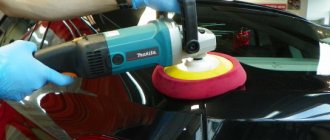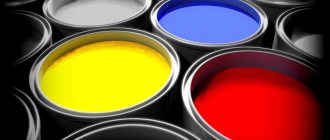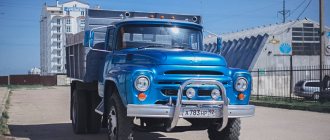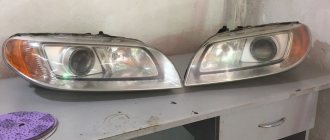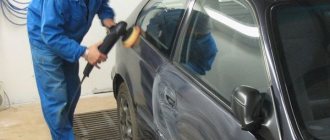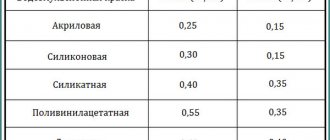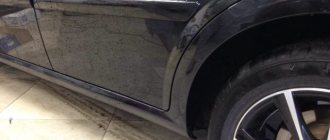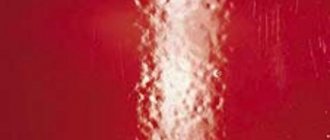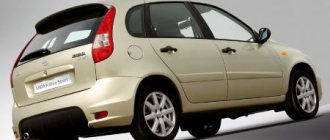Paint applied to the surface must be dried. The drying method should be thought out in advance. There are three ways to do this: natural, conventional and infrared. The third option has the highest efficiency.
- frame,
- reflectors or spotlights,
- emitters,
- Control block,
- stand, IR lamp stand.
Stands are divided into stationary and mobile. Mobile dryers move throughout the room where the car is parked. The pantographic strut is equipped with a gas shock absorber.
They can be classified according to the following characteristics:
- power,
- radiation efficiency,
- wavelength of light.
Equipment is divided into three types:
- Short wavelengths illuminate from 0.7 to 2.5 microns. They dry the car faster, but if the operating mode is incorrect, they will burn through the paintwork. The choice is yours what is more important - speed or safety.
- Medium wavelengths illuminate from 2.5 to 50 microns.
- Long wavelengths illuminate from 50 to 2000 microns.
Other distinctive features:
- Lighting color: white, red or blue.
- Form.
- Design type: halogen or incandescent lamps.
- Dimensions: portable, portable and stationary.
- Maximum temperature. The higher the indicator, the greater the opportunities open up.
IR drying
IR radiation is one of the main methods of curing paint coatings in industrial conditions.
Features of IR drying, on which the drying speed and quality of the coating depend. The spectrum of solar radiation, depending on the wavelength, is divided into 7 ranges or types of waves. These are gamma radiation, x-rays, ultraviolet radiation, visible light, infrared radiation, microwaves, radio waves. The human eye can perceive only one type of radiation - it is called “visible radiation”. We call visible radiation light, a striking example of which is the rainbow, where white light is divided into colors from violet to red
Infrared radiation was discovered at the beginning of the 19th century by the English physicist W. Herschel. Using a sensitive thermometer, he proved that radiation exists beyond the visible spectrum. Continuing his experiments, he discovered that outside the red spectrum there was an increase in temperature. Subsequently, it was found that such radiation comes from any heated bodies and objects, and when a substance absorbs this radiation, it heats up.
Principle of use
The operating principle of infrared lamps for drying paint is simple and borrowed by people from nature. The sun's rays heat the surface of the earth, and it releases heat into the air. This is how infrared lamps for drying cars work: the radiation is absorbed by the metal body of the car and heats it up.
Now let's figure out how to work with the equipment:
- Find out the manufacturer's recommended conditions for drying your car. They are usually indicated in the car enamel documentation. This should not be neglected: improper fastening will damage the machine. If you exceed the maximum curing temperature of the enamel, it will crack.
- Connect the device to the network.
- Select the optimal mode. Set the wavelength, temperature and timer.
- Carefully inspect the surface when the drying time is complete. Check the quality of the coating and start polishing the paintwork.
IR drying does not require special preparation. Read the instructions and documentation carefully and wait until the paintwork has completely dried.
IR radiation
Infrared radiation is electromagnetic radiation that occupies the spectral range between the red limit of visible radiation and short-wave radio radiation.
The entire region of infrared radiation is divided into 3 ranges:
short-wave (beam length 0.74 - 2.5 microns)
medium wave (beam length 2.5 - 50 µm)
long-wave (beam length 50 - 2000 microns)
Artificial sources of infrared waves are incandescent lamps, metal and ceramic plates, spirals, gas burners, etc. Today, IR radiation is widely used in various areas of our lives: in medicine and cosmetology, in the electronics and food industries. They make many devices based on infrared radiation: night vision devices, remote controls, currency detectors, infrared spotlights, heaters, etc. A current and promising direction is the use of thermal energy of infrared waves for sterilization and drying of various materials and products. In this way, food products are disinfected and dried, as well as paint and varnish materials in various fields of industry.
IR - curing (drying)
In industrial production, three main methods of drying paints and varnishes are mainly used: thermoradiation (using IR radiation), convective (using hot air) and combined.
Infrared radiation allows you to work with almost all types of paints and enamels, including acrylic and water-soluble. Allows drying of primers and putties. During drying, paints and varnishes change from a liquid to a solid state, which chemists call curing.
During convective drying in the chamber, the top layer of the coating is the first to heat up and dry, which subsequently prevents the release of the solvent. When using long-wave infrared radiation, heat is also mainly transferred using convection heating. The radiation source is heated to a maximum temperature of +750 C, while the drying object is heated to +40 C. Therefore, the heating and cooling period is 15 - 20 minutes.
When drying with a medium-wave device, the energy source reaches a temperature of +750 - +1450 C, and the drying object itself heats up to +80 C. 75% of the radiation is absorbed by the bottom layer of paint, which in turn heats the entire film. Modern mid-wave IR drying chambers and lamps are suitable for drying various surfaces: MDF panels, decorative glassware, bottles. The correct selection of the IR drying device and the distance to the surface allows the plastic to be dried efficiently after painting. Various products are dried in this way: TV cases, exterior parts (bumpers, side mirrors) and interior parts (handles, dashboard elements) of cars.
During short-wave infrared drying, the product is heated by radiation, which penetrates through the layer of paint and varnish material and is absorbed by 90% of the substrate surface. The radiation source can reach a maximum temperature of 3000 C. The paint is heated from the substrate and promotes the unhindered release of volatile products from the film. Thanks to this, the process of forming the paint coating is significantly accelerated. This is one of the main advantages of short-wave infrared drying. And the second advantage is a significant acceleration in the rise in temperature of the painted product. IR heating of the product in the IR ray zone occurs immediately, almost instantly, whereas with convective drying it takes time to heat the chamber and the product itself.
To choose the right infrared drying device, you need to pay attention to a large number of factors influencing the process: this is the maximum possible heating temperature of the substrate material, the power of the energy source and the distance to the coating surface, the weight and size of the product. You also need to take into account that the drying time depends on the color of the paint and its composition, since different materials have different reflectivity. Light paint reflects some of the rays without absorbing them, so it takes longer to dry. Metallic paints enhance this effect. The aluminum particles present in them reflect the rays like a mirror. Dark paints dry much faster than light ones.
Recently, IR drying technology has become increasingly popular. Enterprises mainly use short- and medium-wave IR emitters. Combination drying chambers that combine IR lamps with electric or gas heaters are also actively used. The reason for this is significant energy savings, reduction in the duration of the drying process, optimal ability to adapt to the size and geometry of the drying object, as well as the low cost of heating devices.
Advantages of IR lamps
Drying your car has a number of advantages:
- The paint layer dries from the inside. The coating does not crack or swell.
- Possibility of local drying. If only the hood is painted, why dry the entire car? Portable ones can easily cope with this task.
- The equipment does not waste time on warming up or setting up. Turned it on, selected the desired mode - the lamps work and fix the coating.
- Minimum energy costs. An important indicator when the entire machine is processed.
- Allows the use of powder paints at home. Their pour point is about 200 °C. Previously, this was how they worked in factories where the appropriate equipment was installed. Modern lamps maintain high temperatures.
- Quick heating of the surface to be dried: you won’t have to wait long.
- Perfection of technology. The presence of a smart control system greatly facilitates the work with the equipment.
- Many operating modes. Different paints and conditions require different work settings.
Questions and answers
We have many clients who have already organized similar enterprises. Typically, IR drying cabinets of the Universal-SD-4, Universal-SD-4-40, and Omegadrive-SD-4 series are used for these purposes. Loading of by-products into the cabinet is about 100 kg. If you need more productivity, drying chambers are suitable - K-100, K-200, K-300.
Our equipment produces fruit snacks, including apple chips.
Our drying chambers can be powered by a gas boiler.
The topic is very interesting. Such products are dried on our equipment. It turns out very tasty!
Tunnel drying chambers have the problems you mentioned. The unevenness of drying is due to the fact that in a large, leaky volume it is quite difficult to control the drying process (drying) of a product of intermediate moisture content, which in this case is fish. The appearance of “sweetness” is due to the fact that, due to the characteristics of air exchange, air masses passing through the raw product immediately fall on the already dried product. For this reason, microbiology in tunnel installations is not very good.
This is an IR drying cabinet - Universal-SD-2P
Many manufacturers underestimate energy costs for water evaporation. After all, the lower the consumption, the more economical the drying unit operates. The figure often cited is 0.9-1 kW per 1 kg of evaporated moisture. Our drying units have similar energy consumption. But in any system there are a number of factors that can increase this consumption. Firstly, it is thermal insulation. Secondly, this is setting up the equipment. Thirdly, the type of product, its cutting, layout, technology and drying modes. Therefore, it would be more correct to calculate energy consumption based on the figure of 1.25 kW per 1 kg of evaporated moisture.
Price is certainly an important, but not the main factor when deciding to purchase industrial drying equipment. We produce both serial drying installations and drying systems based on individual projects, taking into account the specifics of production and drying technology. Therefore, we first try to understand what exactly the client needs, and only then offer an equipment option and price for it. To simplify the work, it is proposed to fill out the form (questionnaire) using the link - select equipment
The question is not clear-cut. This may depend on several factors. One of them is the region where the production is installed. If we talk about the Russian Federation, the most economical form of energy today is natural gas. When burning 1 cubic meter of gas, 10 kW of energy is produced. The cost of 1 cubic meter of gas today is 5-6 rubles. The cost of 1 kW of electrical energy is approximately 4-5 rubles. This means drying products using natural gas will be almost 10 times cheaper than drying using electricity.
Drying and drying fish is a delicate and not easy process. You can dry fish in our equipment. But there are nuances about which it is best to consult with our managers. Contact us.
Yes, sure. There are models specially designed for this. Our equipment is used to dry herbs and medicinal plants in monasteries and medical enterprises, as well as many companies producing Ivan tea.
In some cases, IR drying really gives a good effect. This is usually drying in a thin layer of product, no more than 5-7 mm. But there are products that it makes absolutely no sense to dry using the IR method, since this will quickly remove moisture from the surface of the product, and the moisture from the inside will not have time to reach the surface and after drying the product will remain damp. A crust will form on the outside of the product. This applies to many fruits, for example.
We have a fairly wide range of equipment. Including productive ones. But often increasing the drying speed is inversely proportional to the quality of the resulting product. Not to mention the peculiarities of food drying technology and energy consumption. If energy allows, it is possible to create a very high-performance drying plant.
It is not difficult to learn how to operate and operate our equipment. But it is important to understand the features of drying different products, understand the technology and structural features of the products, and based on the above, set drying modes. But in any case, if you are opening even a small production, an experienced technologist will not be amiss. Contact us. We will help.
The fact is that we do not specifically indicate in the technical information about our equipment the mass of raw materials to be loaded. In order to correctly indicate the mass of raw materials that can be loaded into the drying chamber, you need to know the following information: type of raw materials, type and size of cutting, initial and final moisture content of raw materials, bulk mass. While this data is not available, it is even difficult to say approximately what weight of your product will fit into this or that model of our drying chambers. But we indicate the number of baking sheets and the area of product layout. And knowing your specified parameters, it will not be difficult to calculate the exact weight. If you want us to do this, please fill out the EQUIPMENT SELECTION FORM
Homemade lamp for drying paint and putty
I struggled for a long time and found the most convenient way for drying painted parts. Previously, I tried various devices - flat heaters, heaters with fans, this included my “Miracle Stove” Falco-Eckel and a gas gun, various large lamps and sets of Chinese 500-watt spotlights, and even something else. All this turned out to be not convenient and impractical in all cases.
After painting, any fans that raise dust are excluded from the room. For this reason, a gas gun or powerful “breeze” heaters that direct warm air onto the part are also no longer needed. I also tried using the Falco-Eckel oven. But it is ineffective if you heat vertical surfaces. The heat comes from it mainly from the top, so it is convenient to use the oven when drying a horizontally placed removed part. So only the lamps remain. In fact, chance helped. They just gave me one very powerful lamp. I tried to clarify the name, but I couldn’t figure out what it’s called: quartz or non-quartz or something else. As if there are similar ones - they are used to light or heat either in old Russian microwaves, or in medical offices, or these are lamps from spotlights from railway lines.
Mine (now from the store) is very hot and very bright. There are similar ones for professional drying, which are very expensive on sale. Now it’s time to “repair” your lamp, look for the main element and re-install it in a homemade housing. This is what the photographs are about. This lamp provides more than enough heat. Photo of what it looks like disassembled and where I start preparing the new case. The appearance of the product is absolutely unsightly. But I will be very upset if this lamp breaks or fails; it would be better if my 2000 ruble hairdryer breaks or my semi-automatic welding machine stops working. I always know what I can replace them with. It’s different with this lamp, I haven’t found a replacement for it yet. I use it to illuminate my spot painting, dry putty stains, and dry express primer. Those. it is universal. Next, how to assemble it. You need a sheet of metal and you need a wooden handle to hold and carry this lamp. You can burn yourself with a lamp and it should not blind your eyes - it warms and shines so powerfully. A sheet of metal is bent and (from it) we make a “whisker” that will support this lamp. The handle will be wooden; we fasten it from the inside with ordinary long self-tapping screws. And that's basically all. Gets this look. We connect a microswitch through one wire and attach the wiring to the handle - the switch should not dangle and the lamp should not fall often. Although it can withstand this too. Next we check how it shines. Even now, in order to turn on the lamp and take a photo, I placed a metal spacer under the lamp. The paper or fabric may smoke. Within two minutes the smell of burning body paint appeared. It will burn evenly over time.
He told me about the lamp. Later, another reason appeared to take a photo with this lamp. It has a power button for convenience. At first I used inconvenient manual switches for these purposes, then I started using (and not only on this lamp) switches from the car’s dashboard. This turned out to be very convenient, especially for an angle grinder. You can lightly press the button and the grinder will start working until you let go, you can press the button harder and lock it.
Video of this lamp after another “modernization” and now the purchase of its main element in the store.
. and a link to Electrical Installation
In 2021, the topic is still alive.
I moved to a new garage and made myself such a lamp again. Besides. There was a man who came and bought it. Expensive. I didn’t want to assemble it myself. Again I’ll have to make a new one myself. About connecting wires to the lamp. I haven’t found anything simpler for myself than to simply free the edges of the element lamp from the ceramic and screw the wires there, even without soldering.
How to remove ceramics. When cleaning it, the contact itself may well break off. “Pliers, pliers” is not an option. Adapted. I start sawing the ceramics with a grinder, the ceramics don’t cut, but after 20 seconds the heating starts to crumble and fall off in large pieces. The contact is exposed.
Although buying standard fasteners is, of course, also an option……… Many people thought that this was an ordinary lamp for a spotlight. No, it's still a different lamp. It warms up more.
After all, it is called “Quartz halogen thermal emitter.” The lamp power of 500 W is quite enough. If you use a lamp with a power of 1000 W, then it is impossible to stay indoors, the lamp “hurts” your eyes so much.
…………………………………………….. There is a separate entry on the site about various homemade devices
Related Posts
- Putty for cars. Types of putty
Features of infrared emitters
The resistive coil of the heaters is placed in a material that is capable of producing infrared radiation. Surfaces for generating IR radiation can be:
Conventional light bulbs differ from infrared lamps in their filament temperature. For example, light bulbs heat up to 2600 °C on an incandescent coil, and in infrared lamps the temperature of the coil does not exceed 800-2200 °C, depending on the type of heater. Infrared lamps convert about 80 percent of the electricity into infrared heat. Metal reflectors used for IR emitters in infrared modules and infrared panels allow you to direct heat in the desired direction. The waves will be reflected from the mirror metal and directed towards the material for effective heating.
Benefits of infrared food drying
The main advantage of the infrared method of drying products is the high rate of moisture evaporation , which is much higher than drying with convection or contact heaters. This is explained by the fact that infrared rays penetrate deeper than the surface of the material, approximately 0.1-2 mm for capillary porous food products. Reflecting from the capillaries, infrared rays change direction inside the product many times and are thus almost completely absorbed into the product. In this case, the heat transfer coefficient is quite high, which means the transfer of a large amount of heat per unit surface of the drying product.
The described advantage of infrared dryers greatly speeds up the drying process. For example, in the textile industry, infrared drying of fabrics speeds up 30-100 times! Approximately the same figures are obtained when assessing the drying efficiency for other materials with a thin layer, for example, for painting metal, wood, cardboard, and plastic.
Types of infrared dryers
In this article we will look at two types of infrared drying chambers: based on radiation emitters heated by gas installations, and based on electric infrared emitters.
Gas dryers have a fairly simple design diagram, which you can see in the diagram. The radiant panel is heated by gas using burners. In some cases, flue gases inside the emitters may also be used. Radiation dryers must use an intermittent drying method to avoid thermal diffusion moisture flow, which slows down the release of water from the internal layers.
A classic infrared dryer using infrared electric heaters can have a different design: these are infrared drying panels, tunnel dryers, infrared modules for drying car paint, metal powder coating polymerization ovens, and many others. Consider the blown-air conveyor dryer shown in the diagram below.
Infrared heater panels can be made from ceramic infrared emitters or tubular quartz glass heaters.
How to choose the right IR lamp
High-quality equipment is the key to success in any endeavor, especially when it comes to a car. Painting and infrared drying has become popular, and a huge selection of products has appeared on the market. And the price of the device is rather high. How to choose the right lamp and not regret the purchase later?
The first and most important thing is to study the features of what you are looking for in advance. This will prevent you from falling into the trap of talented sellers pushing extra goods. Find out all the nuances in advance - on the Internet, from friends, take into account your needs, budget, and then go to the store.
Consider the characteristics of the lamps. At home, portable medium-wave “soft” lamps are more convenient. The average temperature on the surface is 60 ºС, and the wavelength is 500 mm. Other types of lamps will require experience with the equipment.
Brand and cost are important factors. A well-known brand has its advantages and disadvantages. There is no need to buy something from a company that has no reviews at all. IR lamps for drying paint are not cheap, but is it worth paying extra? No. The lower price is a nice bonus, but not at the expense of quality.
Features of various types of infrared emitters for drying
Ceramic infrared emitters are characterized by uniform heating. They are recommended for use in dryers with constant heat. At the same time, to provide a larger radiation area, it is recommended to use the ECS-1 model of spherical ceramic infrared emitters. The curved surface of the emitter of this model scatters infrared waves at an angle of 75 degrees, which, together with the mirror metal reflectors placed inside the oven, allows infrared radiation to be evenly distributed throughout the material.
In cases where it is necessary to frequently interrupt heating or drying occurs in a cyclic mode, it is necessary to use tubular quartz heaters, the heating time of which is only a few seconds. At the Polymernagrev company you can buy tubular quartz emitters of three types:
- Quartz tubular halogen lamps KGT, in which the cavity between the spiral and the tube is filled with halogen gas.
- Classic quartz tubular emitters with a nichrome spiral inside, which are used to create QP series quartz heaters, as well as in infrared quartz panels
- Quartz tubular carbon thermal emitters, in which a high-tech carbon fiber spiral is placed inside the quartz tube as a heating element.
On the Polymernagrev website you can not only buy the necessary heaters for your drying installations, but also order the development of an individual dryer from us. Among the ready-made equipment, we have powder coating polymerization chambers, car paint dryers, infrared panels with ceramic or quartz emitters.
Call us by phone or just in the comments, we will contact you and answer all your questions.
Heating of the spray booth. Heat exchangers, heat generators and IR heaters.
The heating system in the paint booth allows the master to carry out painting work at any time of the year, even in severe frosts, providing the required temperature level in the working environment. In addition, in addition to creating a comfortable microclimate, due to warm air masses, the drying process of the applied coating is also significantly accelerated, which is economically beneficial when conducting commercial activities in the field of painting services.
Why do you need a heating system?
The content of the article
When constructing an air heating system in a chamber, you must first take care of good thermal insulation of all zones in the workspace, from the walls, ceiling and ending with the floor covering. Ideally, a well-insulated spray booth should be a thermos, heating which will require a minimum of energy resources, which will have a positive effect on the economical operation of such a structure. All materials used for finishing and insulation must be non-flammable. The second point is the ability to quickly cool the chamber by blowing cold air.
By following all these recommendations, you can speed up the drying process and ensure the required temperature conditions for applying the coating while saving your budget on electricity, gas, or diesel fuel. This is precisely the main task of the air mass heating system.
Heating options for spray booths
To use the working room of the chamber in the coating drying mode, two options for heating the air are used:
- Classic scheme. Drying due to the forced supply of hot air into the room.
- Mobile option. Installation of infrared heaters on all sides of treated surfaces.
It is worth noting that there is no need to talk about natural drying of paintwork, since this is a long process, and standard auto repair shops try to reduce it as much as possible in terms of speed of work and commercial benefits.
The classic scheme for drying and heating air is used at stationary service stations, where there is a large flow of cars and orders for painting individual parts. With intensive use, the costs of the heating and recovery system of the spray booth will pay off fairly quickly.
IR heaters are used for small orders, or at the beginning of building your own workshop. Small initial investments + mobility and cost-effectiveness make them a good option for starting your own business. Infrared lamps are capable of drying various parts quite well after painting, puttying or varnishing, even at low temperatures in the garage or box where the camera is installed, but in terms of the quality of drying of large items they are inferior to classic hot air blowing.
Basic requirements that must be observed when designing heating units.
- An installed thermostat that will protect the heat exchanger for the paint booth from overheating.
- Grounding all wiring.
- Matching the performance of the heat generator part of the structure and ventilation.
- The maximum air heating temperature should not exceed +65 degrees, since plastic and rubber parts of the car body may be damaged if this value is exceeded. And at +80 degrees the paint begins to fade.
Also, the camera must fully comply with fire safety requirements. As you can see, the tasks facing this structure are serious, so we would not recommend building it yourself, but rather turn to experienced specialists who will competently install not only heating systems, but also protection in case of an emergency breakdown.
Structure of the heating system of the spray booth
To understand how the heating and air heating system works, you need to understand what components this structure consists of, there are several of them:
- Heat generator. A chamber in which gas or diesel fuel is burned. In other words, a burner.
- Air heat exchanger.
- Ventilation system.
Ventilation is calculated based on air exchange rates. But the first two nodes form indicators of heat transfer in the chamber.
Heat generators
An air heat generator is a system that heats air using electricity or burning certain types of fuel. The power of such systems can reach 1000 kW, and this indicator is distributed according to the following principle: 40% - combustion chamber, 50-55% - heat exchangers and fans. The ventilation power in the chamber affects the heat exchanger and, due to it, a pressure of about 1000 Pa is created in the working room, and the admixture of gases raises the temperature by 3% - 5%. Constantly adjusting the temperature level is essential.
Electric heaters
Such a heat generator is a set of heating elements, which together heat the air masses in the paint booth. They are cheap and highly popular. Disadvantages: prolonged air heating and high electricity consumption (up to 200 kW).
Gas heat generator
Economical and cost-effective heating system for the spray booth. But at the stage of its design, installation and regular maintenance + approval of all documentation and permits, you will need to spend serious money on all these activities. Payback will only occur with a large number of orders, and then you will save on energy consumption.
Diesel
This is an inexpensive option for installing a heat generator, which is often used by craftsmen at the initial stage of work. All fuel costs must be included in the cost of work.
What is a heat exchanger?
This is a system in which heating occurs according to the principle from hot to cold. There are two main types of heat exchanger on the market.
Recuperative heat exchanger
It is based on two air duct channels, inside which cold and hot air masses move separately. Heat exchange occurs between the walls of the channels. The walls themselves, according to their shape and design, are divided into the following types:
- Ribbed.
- Spiral.
- Lamellar.
When calculating, they mainly take into account not the shape, but the area and dimensions of the heat exchanger.
Regenerative heat exchanger option
Their main difference is in several points.
- The channels are mainly made of stainless steel, and significantly reduce the possibility of overheating.
- They are used in conjunction with an air recirculation system, which also requires additional financial costs.
We can draw a small conclusion that it is better to look towards IR heaters and diesel generators as an energy resource at the start of your business, and in the future install a gas burner for the paint booth.
What type of heater and system do you use? We look forward to your comments below. Thanks in advance for your answer.
Frequently asked questions about infrared drying
Infrared drying (IR)
p, blockquote 1,0,0,0,0 —>
What is IS?
p, blockquote 2,0,0,0,0 —>
An IC is essentially a short-wave infrared emitter used to accelerate the drying and curing of materials used in auto body repair. Infrared rays penetrate into the applied layers of materials and dry them throughout their entire depth. This results in faster and better drying of the repair surface. ———————————————-
p, blockquote 3,0,0,0,0 —>
What is shortwave IC?
p, blockquote 4,0,0,0,0 —>
shortwave infrared emitters have a wavelength from 0.7 to 2.5 microns and have a heating element temperature of more than 800 degrees Celsius. Short-wave emitters are usually used for professional purposes and heat up quickly. In comparison, long-wave infrared emitters have a wavelength from 50 to 200 microns and the heating element has a temperature of about 300 degrees Celsius and are used more often in everyday life, as heaters. ———————————————-
p, blockquote 5,0,1,0,0 —>
Is it possible to do without IP?
p, blockquote 6,0,0,0,0 —>
Without IC, applied products will dry more slowly, starting from the surface. Depending on the amount of repair materials applied, subsidence usually occurs in the future. Thus, repair materials on an already repaired part sag and traces of repair appear in the form of scratches from sanding paper and irregularities. When using IC, subsidence is minimized, and with proper repair it is eliminated. ———————————————-
p, blockquote 7,0,0,0,0 —>
Why use IP?
p, blockquote 8,0,0,0,0 —>
The use of IS speeds up the work process and improves the quality of the repairs performed. ———————————————-
p, blockquote 9,0,0,0,0 —>
Can an infrared heater be used as an IC?
p, blockquote 10,1,0,0,0 —>
The infrared heater differs in the length of its infrared waves and lacks some of the automatic timers found on professional ICs. As practice shows, infrared household heaters are quite capable of performing the IC function for body repairs.
p, blockquote 11,0,0,0,0 —>
p, blockquote 12,0,0,0,0 —>
Do I need a timer for the IC?
p, blockquote 13,0,0,0,0 —>
The timer increases the cost of the IC. Of course, there is a benefit, since using a timer you can set the drying time. Without a timer, you will have to control the drying process yourself. ———————————————-
p, blockquote 14,0,0,0,0 —>
p, blockquote 15,0,0,1,0 —>
p, blockquote 16,0,0,0,0 —>
What distance to the part must be maintained when using an IC?
p, blockquote 17,0,0,0,0 —>
The distance depends on the power of the IC and varies from 40 cm to 1 m ————————————————-
p, blockquote 18,0,0,0,0 —>
Share “Frequently asked questions about infrared drying”
Lamp rating
To select the appropriate model, it is useful to compare several popular dryers according to key indicators.
Short wave drying Garwin gi 1lb
A model with a portable stand, used for working with both the topcoat and the compounds applied under it.
Device performance characteristics:
- operating temperatures - +40...+100°С;
- options for changing the position of working elements to direct the rays in the desired direction: rotation, height change;
- model power - 1100 W;
- price - about 15,000 rubles.
Nordberg if 1_220
Infrared drying Nordberg if 1_220.
Another short wave option.
Has the following features:
- temperature range - +40...+75°С;
- recommended distance to the surface is 45-65 cm;
- service area 50x80 cm;
- power - 1100 W;
- price - 9000 rub.
Please note: Choose an electric spray gun for painting a car
